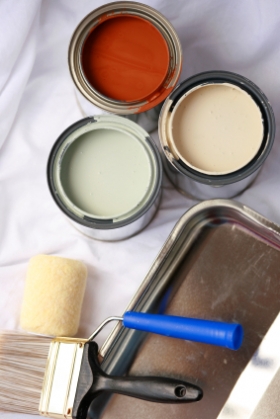How to Reduce the Fumes

A fresh coat of paint can change a room from dreary to divine.
Stains, sealants, caulks, and adhesives help you build everything from a
new bathroom to a bookcase. But all these useful products can also
introduce unhealthy chemicals into your home and your body.
Low-VOC paint:
The biggest culprit is VOCs, or "volatile organic compounds," a large
class of chemicals that readily evaporate at room temperature. If you
walk into a room and notice that new-paint smell, youíre breathing VOCs.
Paints, stains, sealants, caulks, and adhesives release the highest
levels of VOCs when wet. But even when they feel dry to the touch, they
may keep releasing these gases for days, weeks, months, even years.
Meanwhile your upholstery, carpets, and drapes act like sponges,
absorbing VOCs and releasing them over time. While not everyone may be
bothered by exposure to these gases, they can be a serious health risk
for people with chemical sensitivities, asthma, or other respiratory
conditions.
The good news is most major paint companies now offer at least one low-VOC paint, usually a water-based latex. And a few companies offer a full line of zero-VOC paints. Water-based sealants, stains, and floor-finishing products are available now, too.
Fifteen or twenty years ago some of these products didn't work as well their more noxious counterparts, giving low-VOC a bad rap. But the poorer performers have dropped out of the market or been reformulated, and most of todayís products are of good quality.
Top Tips:
- Air out. Provide proper ventilation when using any kind of coatings or adhesives. If youíre working on a small project, do it outdoors if possible. If you must work indoors, open windows. Dust masks donít block VOCs; use a respirator specifically labeled for protection against paint vapors.
- Follow instructions. Always read and follow the directions on the productís label for use, clean up, and safety.
- Seal in poisons. You can apply low- or zero-VOC clear sealants over particle board and other pressed wood products to seal in formaldehyde.
- Store safely. Store leftover paints, sealants, caulks, glues, and the like tightly sealed in their originally containers, preferably in a garage or shed thatís not attached to your house so fumes that leak from the container donít enter your living spaces.
- Recycle it. If you have leftover paint that you donít need, take it to a recycled paint collection site-contact your cityís recycling department or Earth 911 for recycling opportunities.
For more information on buying and disposing of paints and other coatings: http://www.sierraclubgreenhome.com/go-green/paints-finishes-and-adhesives/safe-and-healthy-paints-other-finishes-and-adhesives/
©2010. Copyright Environmental News Network To subscribe or visit go to: http://www.enn.com